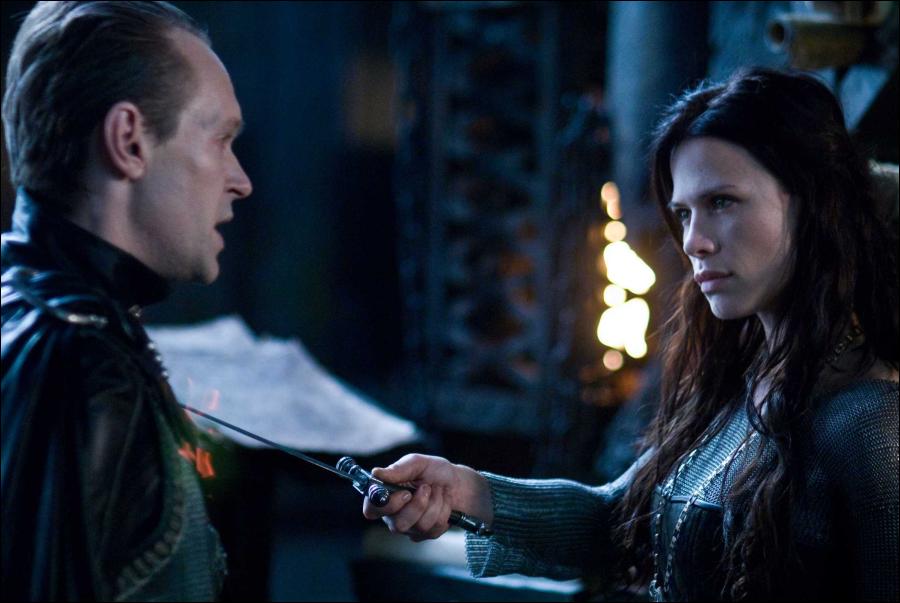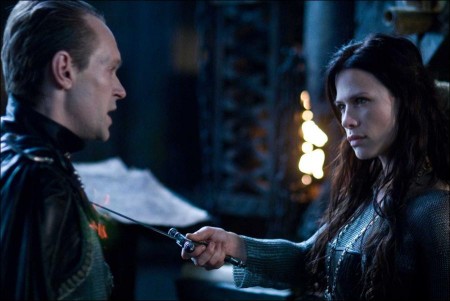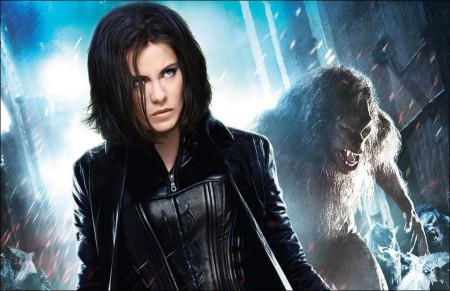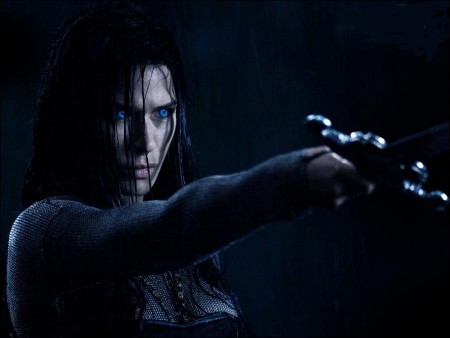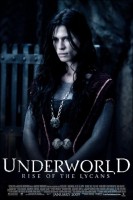About the Production
When Underworld debuted in 2003, its richly imagined telling of a centuries-long war between two immortal races wowed audiences across the globe. Ruthless Vampires and savage werewolves returned in its sequel Underworld: Evolution, and a worldwide audience devoured its elegant visual aesthetic, eerie characters and compelling action.
Now Underworld: Rise of the Lycans takes fans back almost a millennium to the beginning of an epic conflict. Created by longtime friends Len Wiseman and Kevin Grevioux, the film reveals the secrets at the heart of the Underworld saga’s eternal battle. Wiseman, who directed the first two films, has taken on the duties of producer for this installment, while Grevioux returns for the third time in the role of Lycan enforcer Raze. “The history has always been a driving force for Underworld,” says Wiseman. “In the past, we’ve had glimpses of how it all started. Now we’re finally able to play it out with the Death Dealers and their armor and the horses and masses of werewolves.”
Even before the first film was shot, the pair created a complex mythology for their Vampire and werewolf antiheroes. “Kevin and I always intended this to be a trilogy,” says Wiseman, now a sought-after director of films including Live Free or Die Hard. “It was decided at the time to start with the middle story in the timeline, and it is pretty cool now to be doing the prequel that we talked about so long ago.”
“A big part of the whole Underworld series is that the events that have taken place over the last eight centuries determine what’s happening in the present,” says producer Richard Wright. “There are whole sequences in the first film that are devoted to back story. And in the second film, the whole visit to the Tannis character’s lair is eight minutes of back story.
Grevioux wrote the original screenplay with Danny McBride. “Len wanted to do a werewolf movie and asked me if I had any ideas,” he says. “When we started hashing out characters and the overall structure, we thought: ‘What if we did a Romeo and Juliet story, with werewolves on one side and Vampires on the other and make it a cool, surrealistic modern-day love story?’ We also decided to change the way werewolves and Vampires have traditionally been looked at and go more for a scientific basis for their existence, rather than the traditional mysticism.”
Underworld: Rise of the Lycans traces the origin of the age-old rivalry between the Lycans and the Vampires to its ancient beginnings in a forbidden relationship. Lucian (Michael Sheen) is the first Lycan, a creature able to transform from werewolf to human and back again at will. Sonja (Rhona Mitra) is a Death Dealer and the daughter of Viktor (Bill Nighy), a powerful Vampire Elder. “Their relationship actually leads directly to the Lycans’ revolt against the Vampires,” explains Grevioux. “Everything revolves around the fact that Sonja and Lucian are in love with each other. Even though Sonja is Viktor’s daughter, there is an uncontrollable bond that grows between them. That already makes it a different kind of story from the first two stories.”
For the first time in the franchise’s history, Wiseman has turned over the director’s reins to someone else. Patrick Tatopoulos, creator of the first film’s fantastical and frightening creatures, as well as the production designer of the second, was selected to succeed him. Although he says he was happy to pass the torch to someone who has been integral to creating the franchise, Wiseman admits that it was strange at first to see someone else in the director’s chair. “I am seeing it happen from a different seat, but because Patrick and I have a relationship and we’ve built this thing together, it is a very easy atmosphere with us.”
Tatopoulos sees a certain logic in the fact that he makes his directing debut on Underworld: Rise of the Lycans. It is the first of the films to be told primarily from Lucian’s perspective. “I created the werewolf on the first and second films,” says the director. “So I think for the story to be told by the werewolf was a great thing for me. In the past, we’ve seen werewolves, but their presence is never overwhelming. In this case, we have an all-out war with hordes of them. This movie brings a new edge to the story, which helped me to create a different texture for the movie.”
Bill Nighy, who plays the Vampire Elder Viktor, credits the filmmakers’ faith in the franchise for making Underworld: Rise of the Lycans more than just another vampire action movie. “Len Wiseman, Danny McBride and Richard Wright are more than just enthusiasts,” he says. “They’re believers. They’re not winking at the audience. You can cynically build a vampire movie, but I don’t think you’ll have the same kind of success that a believer would.
“They love the vampire myth and they know their vampire law,” he adds. “I love it when it gets Vampire technical. I love to see a Vampire sipping blood in a sophisticated manner. The moral equations are treated with as much respect as they would be in any kind of story.”
Shining A Light On The Cast
The filmmakers of Underworld: Rise of the Lycans were thrilled to have been able to reassemble the cast that created some of the series’ most unforgettable characters, an ensemble that features several distinguished British actors with busy careers. “I had no idea that we’d be able to maintain the cast that we’ve had,” says Wiseman. “I was thrilled to be able to get so many of them back.”
The script explains centuries of enmity between adversaries Lucian (Michael Sheen) and Viktor (Bill Nighy) with plot twists that may subvert fans’ expectations. “Because both those characters were very complex, it was really nice to be able to resurrect them for the prequel in the new context of the historical past,” says Wright.
Sheen, a BAFTA nominee for his work in The Queen with Helen Mirren, has appeared as Lucian in all three movies, taking the character from apparent arch villain to hero. “One thing that Michael always brings to his work is passion,” says Tatopoulos. “There’s nothing that escapes him and every detail of this character is very precise.”
Co-star Nighy agrees. “Michael is one of those very rare actors who will deliver any role with great intelligence, great wit and great power. Nobody in the history of cinema delivers a werewolf as brilliantly and as powerfully as Michael Sheen. I say that with complete confidence.”
After seeing Lucian die in Underground: Evolution, Sheen was happily surprised to have an opportunity to play the character again. “I got the chance to show the story that we heard about in the first film,” says the actor. “In the beginning, you think that he’s the bad guy and then you start to get more information about him. The idea of showing how the character came to be is very attractive.”
After portraying the character twice in the past, Sheen can now explore another side of him. “One of the things in our story that I was most interested in was the idea of Lucian’s relationship to the animal in him,” he continues. “Viktor used Lucian as a teenage boy to create more Lycans. Lucian was so disturbed and traumatized by this experience that he reacted against this animal side of himself, and in fact spends his life up until the point of our story killing werewolves.
“This gives Lucian a very strong inner journey. In trying to find freedom, he has to accept something about himself that he has avoided his entire life. That takes the story slightly further than just a myth.”
Lucian also emerges as a leader for the first time, observes Sheen. “He is someone who is able to inspire brotherhood amongst people who have never felt it.”
The film also reveals a new side of Viktor, the Vampire leader who plays a central role in the other films. “We get to see why Viktor becomes the way he is in the first film,” says Wiseman. “Bill brought a take on Viktor that was different from the one I first saw on the page. He brought a tone to it that I love and I think people get a kick out of his approach.”
Tatopoulos praises Nighy’s tremendous investment in the part. “You never know what the next thing’s going to be, but you expect anything,” he says. “Bill goes from a smile to this incredible twisted face in a second. He’s created a character that’s on the edge of Grand Guignol. It makes him quite scary and intriguing.”
Nighy’s long career on stage and in film and television has made him one of Britain’s most honored actors, and he brings the same commitment to the Vampire ruler as he does to his stage work. “Vampires are, by dint of being Vampires, cool,” Nighy says. “Being senior Vampire, I get to snarl and sneer and to be tortured, too. He is of two minds about some of the stuff that he gets up to. You are led to believe that he has feelings of a kind of normal nature, but that he is emotionally challenged. This is a man who drinks his daughter’s blood and then arranges for her to be burnt to toast.”
Viktor’s relative youth in this film meant Nighy spent far less time in the makeup chair. “I had to spend six hours in prosthetic makeup for the first one, where I’d been asleep for hundreds of years and was, strictly speaking, fleshless,” he remembers. “I also get to wear a full-length velvet skirt. It’s not often that I have an excuse for that and it’s liberating and kind of funky. I am fractionally Scottish, so it’s almost legitimate for me to put on a kilt. Not that I often do. I did once though, and I was surprised at how satisfying it felt.”
Actress Kate Beckinsale left an indelible mark on the Underworld franchise with her fierce portrayal of Selene, the Death Dealer, in the first two chapters. Rhona Mitra was initially apprehensive about joining a franchise so closely associated with, as she says, “another British, brunette actress. Once I understood it was a prequel and a complete departure in terms of the character, I knew I could carve out something for myself.”
The filmmakers praise Mitra’s ability to capture the contradictory elements of Sonja’s personality. “It was very hard to find somebody with the toughness you need from the Death Dealer, who also has a vulnerable side,” says Wiseman. “I think it’s a very difficult thing to pull off as deftly as Rhona has.” The character reminds Tatopoulos of Selene in many ways. “Sonja is to me the archetype for Selene,” he says. “Sonja is a warrior, but there’s something very fragile in her as well. She’s definitely a strong fighter, but emotionally she’s very charged as well. And she can become quite sensitive.”
Playing the Vampire assassin is an entirely new experience for Mitra. “This is a complete departure from any roles that I have played,” she says. “She is incredibly empowered. Sonja is a quite passionate female who embodies all of these warrior-like qualities, but also this wonderful femininity. It is quite seductive and enticing.”
Even though she is a newcomer to the franchise, Mitra says her co-stars made her immediately comfortable on set. “I had never worked with Bill or Michael before. Bill is a rock star in his own right. He lends himself so brilliantly and so gracefully to the Vampire world. And Michael’s preparation for this role was really exemplary. People always say, ‘Oh, I’m so blessed, and it’s such an honor’ but it genuinely was. The bar was set high and I had to rise to the occasion.”
When Kevin Grevioux was creating the complex universe of Underworld, he made sure to include a juicy part for himself: Lucian’s lieutenant, Raze. In Underworld: Rise of the Lycans, he has an opportunity to explore the origins of the character. “In this story, we finally deal with how he came to be a Lycan and how he came to have this special relationship with Lucian,” Grevioux says. “Raze was somebody that Lucian trusted, a powerful human among the slaves, which is why Lucian wanted him in his Lycan family.”
Steven Mackintosh again plays Tannis, the Vampire archivist. “I wasn’t creating a character from scratch,” he says. “But there is a difference. The earlier incarnation of Tannis is different. By the time we catch up with him in Evolution, he’s been in hiding for quite a long time and he’s living this slightly profligate life. I liken him to the Hugh Hefner of the Vampire world by that time.”
The reassembled cast quickly adjusted to their new director. “Patrick has been incredibly ego-free,” says Sheen. “And it’s been great to see him relishing his role on this film and really taking on that whole thing. And of course he’s brought his brilliant visual sense to this film. It looks amazing.”
Veteran actor Nighy also speaks highly of Tatopoulos. “I can’t say enough about Patrick—he was absolutely brilliant. I ceased to think of him as a first-time director about half way through the first day. He was impeccable and endlessly courteous. He’s charming, sharp and smart; and his background in design and special effects and creatures stood us in very good stead.”
Mitra concurs: “What was so wonderful was how in touch he was with his crew. That created a happy set. Everybody was respected. I think that his level of humility is really evident along with his ability to listen to what people want and what people need.”
Costumes, Creatures, Crypts and Castles
From the start, the Underworld films have been defined by their edgy, stylish visuals, reflected in every aspect of the film from wardrobe and sets to cinematography. In Underworld: Rise of the Lycans, the filmmakers have reinvented the franchise’s signature look with small and large innovations that reflect the film’s epic scope.
After initially considering Romania, the traditional home of the vampire, as the location, the filmmakers decided to shoot in New Zealand, a country with an internationally renowned filmmaking infrastructure thanks to films such as the Lord of the Rings trilogy. New Zealand’s breathtaking landscapes and lush green forests provided the perfect backdrop. “My first reaction was that New Zealand would be too beautiful,” says Tatopoulos. “It’s too gorgeous, too green. We could never do anything evil there. But on our first scouting trip, we saw Woodhill Forest, which looks like a dead forest. When I saw that, I knew it would be great.”
Instead of simply recreating the de-saturated blues and dark, brooding interiors of the first two Underworld films, director of photography Ross Emery brought new depth to the visuals. Because the story is set in the distant past, the mysterious cyan blue hues have been overlaid with a brassy burnished look that gives the third film a period feel. “The first films had very modern fittings, such as fluorescent lighting, but our world here is one of candles, braziers and moonlight,” says Emery. “That gives a much warmer light. We really went for yellows and brasses and mixed in some green to complement the moss and lichen in the external locations.”
And for the first time, the story moves out into daylight. That is a pivotal narrative point, as producer Wright explains. “Lucian’s character develops in big ways in this film, and one of those is finally getting out of the castle, finally getting away from the dominance of nighttime. When he gets out into the world, into greenery and blue skies, it’s a big moment. Suddenly color enters the world.”
Underworld: Rise of the Lycans is the first of the series to be shot in high definition. “For this kind of picture, HD worked perfectly,” says Emery. “It’s a very dark film because Vampires only come out at night. We only had a couple of weeks of exterior scenes in the entire movie. In that kind of environment, HD works beautifully.”
HD also allowed Emery to manipulate the speed of the action for the fight sequences and to enhance the werewolves’ appearance slightly. “We found that the werewolves looked much more menacing and violent when they were shot with a 45° shutter. All their movements look sharper and more aggressive,” he says. “I love HD because you can see what the film is going to look like on set,” says Emery. “You don’t have to imagine what it will be after grading and everything. For a visual person like Patrick, it’s fantastic because he could see on the monitors how the final film will look onscreen. That was a tremendous tool for everyone on the crew because they were able to make adjustments accordingly.”
Emery credits the film’s art department for making his job easier. “All I had to do with these sets was show up and turn on the lights. They were so beautifully detailed and the scenic artists, the construction guys, the finishers and dressers all did fantastic work. It makes my job so much easier when I walk onto a set and literally everywhere I put a camera, it looks fantastic.”
Production designer Dan Hennah is the Academy Award-winning art director of the Lord of the Rings trilogy. “One of the bonuses of this job was working with a really visual director,” he says. “Coming from the background of production design and creature design, Patrick could see what he wanted, and that’s always helpful.”
Tatopoulos insisted that the film’s design avoid the Gothic conventions of the vampire genre. “The film is set in a pre-Gothic period,” says Hennah. “The major influences were Georgian architecture, stone architecture from the borders of Russia, and a Byzantine Turkish influence. I guess it’s sort of a rock opium den!”
Tatopoulos wanted the main set, the castle, to be a massive structure carved out of rock that looms ominously over the characters. While the building itself was created through CGI, the team built the castle courtyard wall and castle façade where most of the action happens. Construction took eight weeks in a huge warehouse studio in South Auckland and employed a team of hundreds of carpenters, painters and plasterers.
“It is very much an underground environment,” says Hennah. “The concept was that the Vampires had taken over an old castle or monastery hewn out of rock and were converting it to their use. That accounts for the slaves and the construction.”
The castle gate is adorned with skulls, a reference to the ancient practice of parading severed heads publicly as a warning to law-breakers and enemies. The skull motif is also chiseled into the rock face over the courtyard, along with carvings that recall Russian Georgian art and Celtic symbols.
Hennah’s master creation is the crypt, an imposing circular room that was painted to simulate intricate mosaics of rich golds, yellows, greens and reds. “If it’s not painted properly, it’s not believable,” says Tatopoulos. “And the finishes on the set were of an incredibly high standard.”
Costumes have been a critical style element in each installment of the Underworld series. For Underworld: Rise of the Lycans, the designers created a new and unique look. The filmmakers wanted something for Sonja that would be warrior-like and sexy, as well as practical for the action sequences. Wendy Partridge, who designed the costumes for the first two Underworld films, produced an outfit featuring thigh-length boots, a leather corset and body armor with chain mail for the fight scenes.
“I don’t know if anyone’s actually ever seen anything quite like it,” says Mitra. “It’s another level in terms of costumes. How anything can look so incredibly masculine but at the same time really sassy is a puzzle. It was a nightmare to put on but I think that it’s worth it, because every time I stepped out of my trailer, I felt like, ‘I am this character.’”
Designer Jane Holland created costumes for the rest of the cast. For Holland, working with Tatopoulos was one of the great pleasures of her career. “He had such a strong sense of where we were going in a visual sense,” she says. “He was so able to express his ideas and he can draw beautifully and quickly. He obviously had strong pictures in his head, but he was open to what we brought to him.
“We were doing a lot of hand-crafted stuff, a lot of leatherwork, metalwork, some beautiful tailoring and a lot of hand-finishing,” she continues. “It’s really exciting to do that and great when you’ve got somebody who appreciates the detail.”
After consulting with Tatopoulos, Holland came up with a concept that combines medieval history references with pure fantasy. For the Vampire council members, Holland created opulent and decadent designs in rich fabrics such as velvet, while the enslaved Lycans were clad in tattered leather and the human characters wore costumes made of burlap.
“Patrick’s image of the Vampires was that they were sleek and narrow, and able to move quickly,” explains Holland. “I worked with that silhouette. They ended up being very tailored. Because we were dealing with night and a dark palette, we used a lot of black and dark colors. We used leathers and textures that would catch the light.”
Viktor’s four outfits include his signature costume, a long cashmere black frock coat with an ornate embroidered collar, cuffs and hemline. He also wears a leather-look waistcoat, tabard and skirt, his ornate armor and a skull helmet.
Lucian and the other slaves were clothed in distressed and aged leather, as if it were a second skin. It was also flexible enough to allow Michael Sheen maximum movement during the demanding fight scenes.
“They do a lot of the work for you,” says Steven Mackintosh of the costumes. “When you walk onto a set in these clothes and see a huge great hall or a courtyard with flaming torches and gateways and portcullises and torture chambers and dungeons, it makes the visual element of this film fantastic. I describe my costume as a cross between Richard the Lionhearted and Black Sabbath, which I think sums it up. It’s medieval, but it’s rock ’n’ roll too.”
Underworld: Rise of the Lycans features several intense, high-octane action scenes, including a one-on-one duel between two powerful Vampires, a bloody encounter between a Death Dealer and werewolves, and the epic Lycan and Vampire battle, which culminates in a final face off between Viktor and Lucian. In order to prepare the actors for the movie’s many challenging action scenes, stunt coordinator Allan Poppleton trained extensively with them before and during production.
Michael Sheen spent several weeks preparing for the role. “I enjoy sword fighting and that kind of stuff, so this gave me an opportunity to do all that. I’ve always considered myself to be a very physical actor and I try to bring as much of that to the character as I can. And given that I was wearing very little at certain points of the film, the more I jumped around when it was cold, the better!”
The fight between Viktor and Sonja was filmed on the castle courtyard set while a rain machine created a raging storm. “We spent most of a week bashing around in the rain with swords and character contact lenses,” Mitra says. “Every time you looked up water got in your eyes and the contact lenses rolled around. “My costume was difficult to work with in the rain,” she adds. “The chain mail was like a cheese-grater on my arms. It was all about being sodden and wet and looking like a drowned rat and trying to look sexy and cavalier!”
Tatopoulos describes the final scene as a clan battle where the stakes are high and the players will fight to the death. A combination of animatronic creatures, live performers and CGI was used to crowd the battlefield with werewolves and Lycans, creating a nightmarish showdown between the Vampires’ superior weaponry and the werewolves’ innate ferocity.
Coming from the creature world, Tatopoulos used the animatronic devices as much as possible, turning to CGI to amplify the effects. “It was very challenging,” recalls the director. “We had to create a sense of the immensity of the fight when we actually had four Lycans and four werewolves. Only two of those guys were mechanical, which means they could move in the shot.
“I found myself framing shots around which of the creatures actually moved,” he says. “I am a strong supporter of the mechanical creatures, but you also need to leave a little space for the CGI, which is in a sense more controllable. I think we found just the right balance.”
These production notes provided by Sony ScreenGems.
Underworld 3: The Rise of the Lycans
Starring: Michael Sheen, Bill Nighy, Rhona Mitra, Steven Mackintosh, Kevin Grevioux, David Ashton, Geraldine Brophy
Directed by: Patrick Tatopoulos
Screenplay by: Danny McBride
Release Date: January 23, 2009
MPAA Rating: R for bloody violence and some sexuality.
Studio: Sony ScreenGems
Box Office Totals
Domestic: $45,802,315 (51.5%)
Foreign: $43,218,880 (48.5%)
Total: $89,021,195 (Worldwide)
